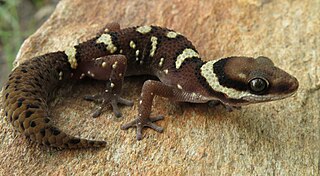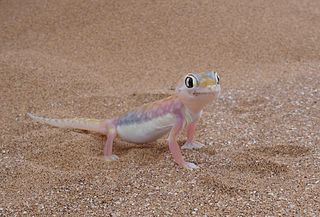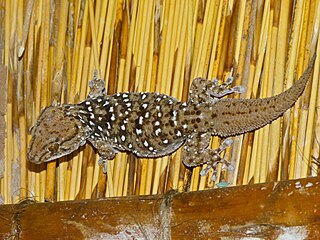
Pachydactylus is a genus of insectivorous geckos, lizards in the family Gekkonidae. The genus is endemic to Africa, and member species are commonly known as thick-toed geckos.

Chondrodactylus is genus of geckos, lizards in the family Gekkonidae. The genus is commonly known as thick-toed geckos. Little is known of their biology.

Underwoodisaurus milii is a species of gecko, a lizard in the family Carphodactylidae. The species is commonly known as the thick-tailed or barking gecko, referring to its distinctive plump tail and sharp, barking defensive call. The genus is also often called thick-tailed geckos as a group, along with the species Uvidicolus sphyrurus.

Chondrodactylus bibronii, commonly known as Bibron's thick-toed gecko, Bibron's sand gecko, or simply Bibron's gecko, is a species of lizard in the family Gekkonidae. The species is native to southern Africa. C. bibronii has been used as an animal model in bioastronautic research examining the effects of spaceflight on the morphology and physiology of vertebrates.

Pachydactylus rangei, the Namib sand gecko or Namib web-footed gecko, is a species of small lizard in the family Gekkonidae. It inhabits the arid areas of Angola, Namibia, and South Africa, and was first described in 1908 by Swedish zoologist Lars Gabriel Andersson, who named it after its finder, German geologist Dr. Paul Range.
Vivian Frederick Maynard FitzSimons, born in Pietermaritzburg, was a notable herpetologist in South Africa. Also, he contributed to the collection of spermatophyte samples for the National Herbarium which has become part of the South African National Biodiversity Institute at the Pretoria National Botanical Garden. In 1937, together with Anna Amelia Obermeyer, he collected some of the earliest plant specimens from the Eastern Highlands of Rhodesia.
Lucasium byrnei, commonly known as the gibber gecko or Byrne's gecko, is a species of small, nocturnal gecko, a lizard in the family Diplodactylidae. The species is endemic to Australia.

Turner's thick-toed gecko is a species of lizard in the family Gekkonidae. The species is endemic to southern Africa.
The Namib day gecko is a species of lizard in the family Gekkonidae. The species is found in the deserts of Namibia and southern Angola. It is the type species and most common member of the genus Rhoptropus.

Chondrodactylus angulifer, also known as the common giant ground gecko, the South African ground gecko, or the Namib sand gecko, is a species of gecko, a lizard in the family Gekkonidae. The species is endemic to southern Africa.
Chondrodactylus fitzsimonsi, also known as Fitzsimons's thick-toed gecko or the button-scaled gecko, is a species of gecko, a lizard in the family Gekkonidae. The species is endemic to southwestern Africa.
Pulitzer's thick-toed gecko is a species of gecko, a lizard in the family Gekkonidae. The species is endemic to southern Africa.
The Cape Cross thick-toed gecko, also known commonly as Koch's gecko and Koch's thick-toed gecko, is a species of gecko, a lizard in the family Gekkonidae. The species is endemic to southern Africa.
Wahlberg's Kalahari gecko, also known commonly as the Kalahari ground gecko, is a species of lizard in the family Gekkonidae. The species is native to southern Africa.
Pachydactylus haackei, also known commonly as Haacke's gecko or Haacke's thick-toed gecko, is a species of lizard in the family Gekkonidae. The species is endemic to Southern Africa.
Monica's gecko, also known commonly as Monica's thick-toed gecko, is a species of lizard in the family Gekkonidae. The species is endemic to southern Africa.
Pachydactylus scherzi is a species of lizard in the family Gekkonidae. The species is native to Southern Africa.
The Namib desert gecko, also known commonly as the Kaoko web-footed gecko, is a species of lizard in the family Gekkonidae. The species is native to southern Africa.

Uroplatinae is a subfamily of geckos in the family Gekkonidae. At least 28 genera have been found to be cluster in a clade together. In the past this was once a monotypic subfamily that included Uroplatus.










